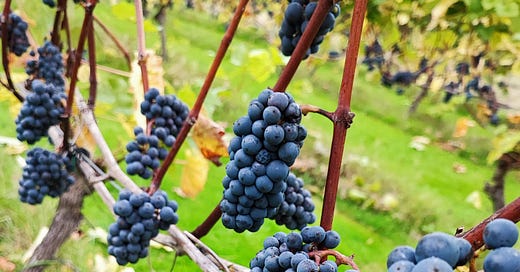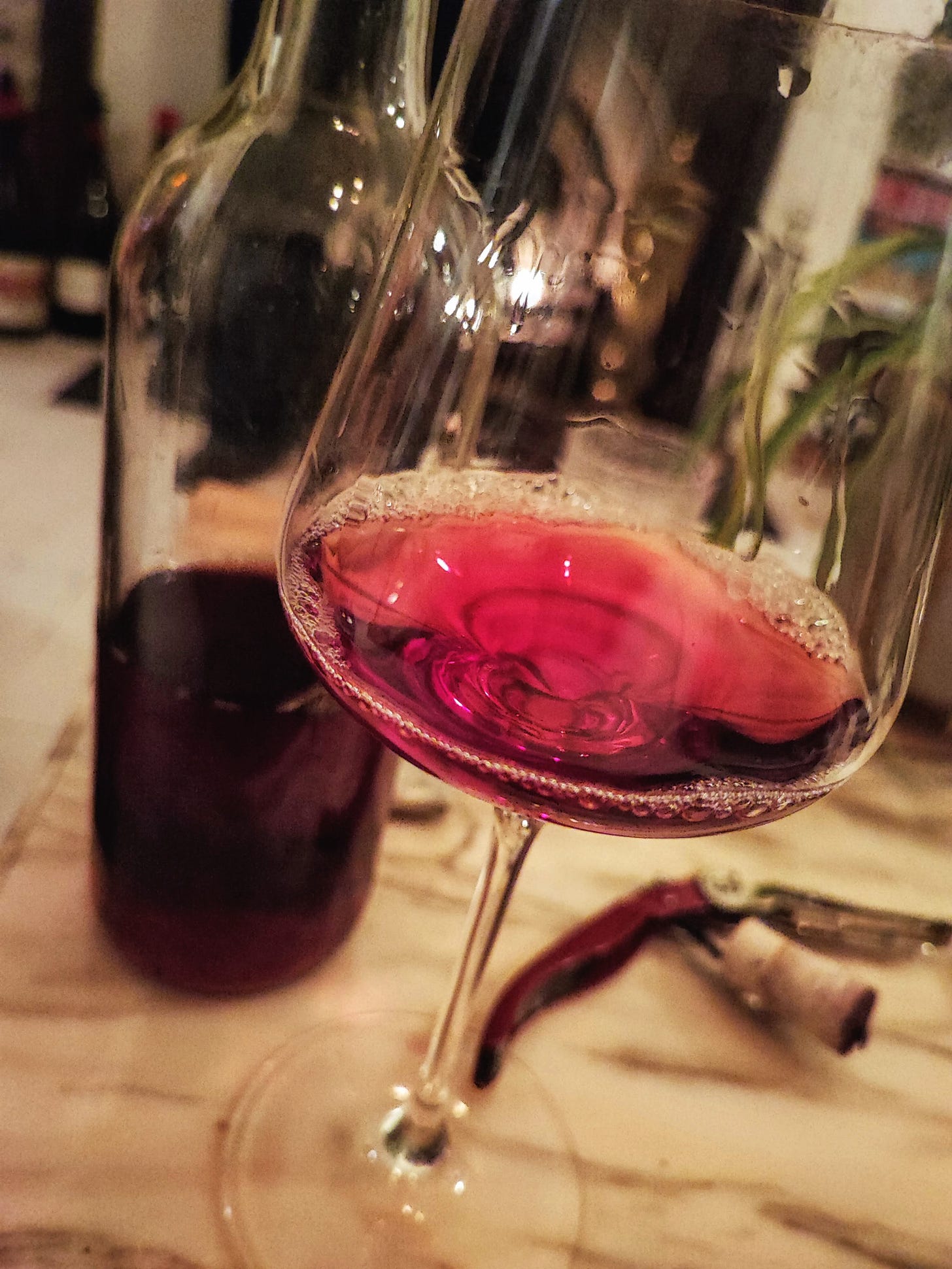Happy accidents and useful lessons
What has gone wrong, and what hasn't, in ten years spent making wine from a few rows of a bizarre grape variety.
Leon Millot, Kent, 2022
Welcome, bubbleheads, and apologies for the lateness of this edition. I have a good excuse, though - harvest.
I have been helping to look after two hundred vines in Kent over the last decade. Two hundred vines is enough to get that vineyard-y feeling; there is a sensation of rows, of order, of repetition. Even on this scale, you start to spot the differences between patches of land just a few metres apart. Birds go for this patch, not that patch. Powdery Mildew hits here, but not here. This vine doesn’t get magnesium deficiency, but the one next to it does. This vine has been killed by some sort of burrowing creature, but the next is a triffid, and so on.
The whole project is terrific fun, for one reason above all others - the grape variety, which, if I was marketing my own wine, I would describe as ultra-rare. Leon Millot is an old French-American hybrid red grape that dates back to the early days of hybridisation post-phylloxera. In terms of disease-resistant hybrids it’s more of a Ford Model-T than the Tesla of today’s best examples, a teinturer (with red pulp) and a flavour that, at best, is somewhere between Cinsault and a kind of gruff, beginner’s Pinot Noir. At worst it is resolutely green and metallic.
Two hundred vines is plenty, in other words.
The absence of any kind of pre-determined idea for what Leon Millot should taste like (I’ve only ever had one, and it was from Holland) has given me a certain amount of poetic license. Yes, I have made a few vintages of Traditional Method sparkling with it, the best of which have come out like some kind of slightly bonkers rosé de saignée. I’ve made reds (all dreadful), and, perhaps with most success, still rosé. In fact, the only think I haven’t tried to make is any kind of dessert or fortified wine.
In the spirit of humility and transparency, here are a few of the things I’ve learnt the hard way. No, none of these wines have ever been sold, or drunk with anything other than a mixture of hope and curiosity. Some of the lessons, though, are ones I remain glad of even when tasting the real stuff.
1. Don’t trust teenagers
Oh, the number of times I have sat there in February, pipette and glass in hand, wondering why this friendly, fruity, strawberry-ish thing has morphed into some kind of hard, gristly, confected mess. The first six months of wine’s life is absolutely wild. It’s an accelerated ride through adolescence, twelve-to-eighteen, death-metal-paint-the-walls-black to carefree sunshine in the blink of an eye.
After a few years you can, at least with your own wines, start to spot whether it will come good. Doing it with somebody else’s during that time, though, is not easy. You have to to able to unpick what is fundamental and what is ethereal. What will remain and what will change.
(Sometimes it stays terrible, though.)
2. Yeasts can really stick their oar in
I once added a yeast called 71-B to a whole bunch-pressed load of Leon Millot destined for rosé. This yeast is renowned as a heavy producer of certain aromatic esters (especially one called isoamyl acetate), although I’d used it as it brings down malic acid slightly (which can be useful if you don’t want the stylistic effects of malolactic fermentation).
Oh my. The horror.
Come the spring, the wine smelt like those ‘Fruit Salad’ sweets we used to receive in party bags as children. Bananas. Strawberry chewing gum. To some it may have seemed ‘fruity’. To me, it was ridiculous.
Since then I’ve been through pretty much every yeast strain I can get my hands on as an unprofessional winemaker. You see things like ‘brings out varietal character’ advertised for certain strains. Sounds good - if you like the varietal character of your grape. A decade of making Leon Millot, though, have mostly been an exercise in suppressing varietal character. Less like picking a tie to distract from your face, more like turning the lights down a little.
It turns out that the Champagne yeast EC-1118 gets that about right (although that doesn’t stop me from fiddling. I’m even using 71B again this year, convinced I just need to leave it to integrate longer…)
3. It’s never the mistakes you think you’re going to make
I read once that winemakers in the Northeastern United States like to practice carbonic maceration with Leon Millot. This technique involves sealing whole bunches in a container, flooding with CO2 and managing the temperature so that berries begin fermenting whole, before they are crushed. I thought that sounded like fun. Of course it did.
Next, then, a year with some lovely ripe, clean bunches, pre-selected in the vineyard. Orders for C02 canisters and regulators, systems for sealing up containers and keeping a consistent temperature. Everything in order. What I really wanted to make sure of, since this was quite a small batch, was that oxygen didn’t get in and start producing masses of volatile acidity.
I had to leave it under supervision for a week. I failed, however, to point out to the supervisor that the thing sticking out out of the top was an airlock to allow gas to escape without letting any in. A fairly critical part of the operation.
I came back to see that the force of the fermentation had blown the top part of the airlock across the room like a bottle rocket. There were my beautiful grapes, peeping up at me through a little hole.
And there, unmistakably, was the smell of a fresh batch of vinegar.
The last bottle of 2013, tasted and, remarkably, enjoyed in 2022
4. Making wine without sulphites is hard
This is a big one. I’m quite proud of it, actually:
I made a mousy wine.
I couldn’t actually believe it when I tasted it. Here it was, the most intriguing, nefarious of faults. Is there a certificate available?
I can tell you how I did it, too:
Very clean grapes, to start off with (poor things). De-stemmed, crushed, macerated, zero sulphites (pH was low, about 3.2). Pressed 8 hours later and fermented with ambient yeasts (some of which may well have been from other ferments in the end). I then inoculated for malolactic, which went by quickly. The whole thing was done with one racking to minimise oxygen ingress. The plan was to bottle with a small sulphite addition.
But, there it was at bottling. The sensation of musty rodent creeping up on you a few seconds after swallowing. A rising halo of brown fur. I kept a bottle to show some friends. “Look! I made a mousy wine!”
Otherwise my minimal-intervention wine was passable - a bit volatile, but in the sort of way that seems to trigger some people into thinking a wine is worthy. I still have some, just for the record.
(I made a parallel wine that year, exactly the same way but with cultured yeasts and 30ppm sulphites at crush. It was pretty good, and mouse-free)
5. You never really now why some wines work
Amongst this litany of mishaps have been some unexpected successes. When are these from? The glorious summer of 2018? No - my vines don’t like ‘good’ years. They are obtuse, contrary beings. They like to be beaten up a bit by some October weather, a nice long hang under greying skies, a cold snap. Carefree sunshine seems to yield wines that are a bit gawky.
Case in point? The best wine I ever made was from 2013. It was picked late, on the 16th October at a magisterial potential alcohol level of…8.5% (after 2012, this was an upgrade). Acidity was certainly perky. The grapes tasted good, but on paper they were a little disadvantaged. They finished malolactic in April.
Both the sparkling wine and the still wine from this year were unfathomably pleasant. A friend actually dug out a bottle of the 2013 still last week - surely the last still in existence - and it was delightful. What was essentially a dark rosé should ordinarily be geriatric stuff at that age. This wasn’t, though.
Why, or how? No idea. I know much more about what I’m doing now than I did then.
Blissful ignorance has made the best wine, though.






